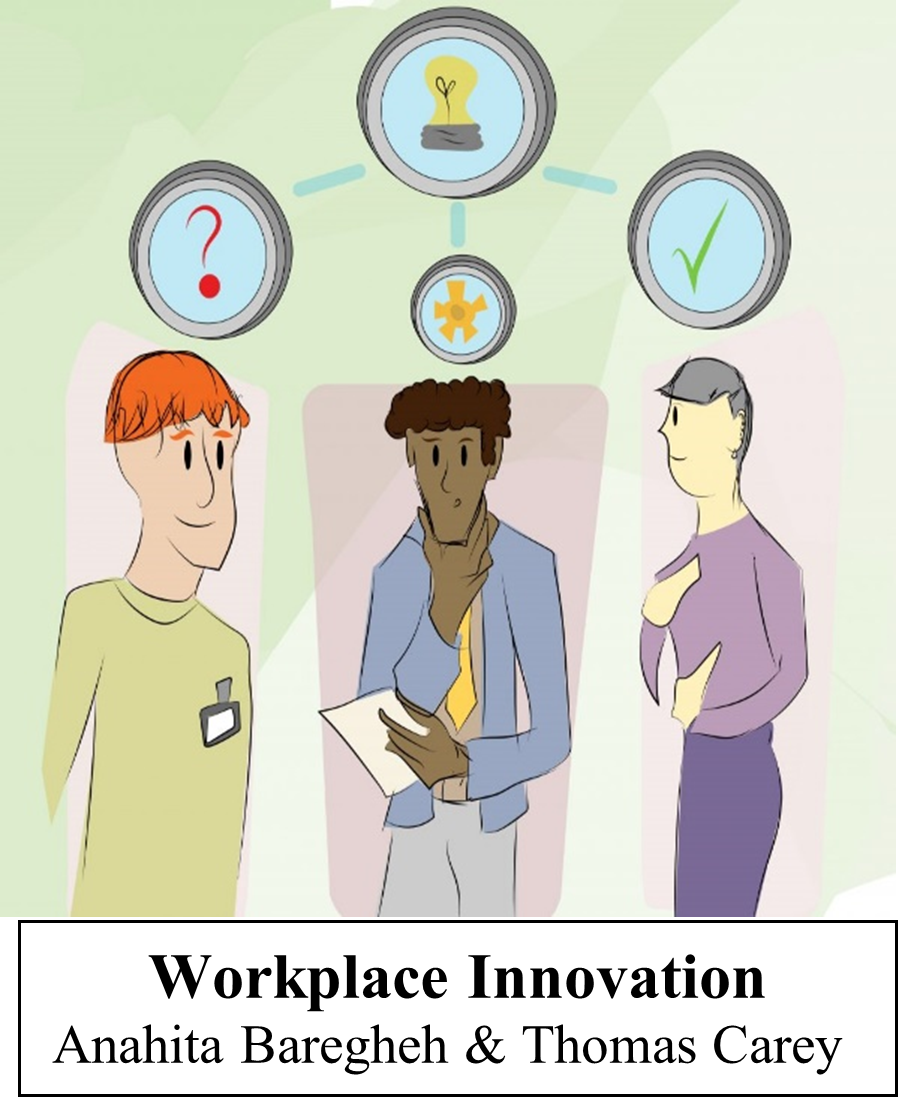Anahita Baregheh is an Associate Professor at Nipissing University’s School of Business and WINCan’s Research Director.
Thomas Carey is co-Principal Catalyst for the Workplace Innovation Network for Canada, Executive-in-Residence with the Monash University Faculty of Arts and a former Associate Vice-President at the University of Waterloo.
One year ago, we began a WINCan project to explore how we could create resources, activities and experiences for adaptable teaching and learning resources which Higher Education institutions could adapt for teaching and learning for Workplace Innovation.
We were basing our project on an Instructional Design for adaptability developed in a previous Ontario-based project with six Ontario colleges and universities and six workplace partners from the corporate and public sectors. We also applied what we had learned in working with our collaborating institution in Melbourne (Australia) in co-developing their pioneering course unit on Understanding Workplace Innovation.
In this series of two posts, we will focus on what we’ve learned over the last year from adapting teaching and learning resources for Workplace Innovation in Higher Education. Our aim is to help Canadian institutions move toward the goal of “Every Graduate Can be an Innovation Enabler” with flexible resources and formats
Re-usable Resources for Higher Education
Two Teaching and Learning resources on Workplace Innovation are now available to Ontario higher education institutions through the eCampus Ontario’s Open Library. The two modules take learners through a sequence of workplace innovation opportunities: Module I introduces workplace innovation and engages learners in Job Crafting, and Module II covers innovation capability as well as illustration cases on Innovation Adaptation (you can see the rationale for these topics in an earlier blog post on our prototype professional development Ladder of Opportunities for workplace innovation).
These modules were tested in an undergraduate 12-week course on Creativity for Innovation (ADMN 3917) in the School of Business at Nipissing University. The remainder of the course resources on Creativity for Innovation included introductory modules to Creativity and Innovation and several topical modules on Critical Thinking, Human- Centered Design, Creativity in Teams, Culture of Creativity and Innovation, and Intrapreneurship.
The pilot class included 36 mostly 3rd and 4th year students from different Business streams such as Accounting, Marketing, Human Resources, as well as a small number of students from outside the School of Business (e.g., Nursing and Education). It should also be highlighted that near half of students were working learners, and were in various workplace positions such as HR manager, Engineering Manager, Nurse, Accountant, etc.
We will focus in this post on the creation and adaptability of these two online learning modules. In the follow-on post, we’ll talk more about how these efforts will lead to development of workplace innovation capability. This will be demonstrated through a series of engagement, assessment, as well as our measurement techniques.
Overall students found the modules valuable, easy to follow and engaging, as illustrated by these representative comments:
“Flows nicely, provides multiple learning opportunities for students, easy to read/understand.”
“I really enjoy these modules compared to other classes, they encourage participation and increase understanding”
“This module was very concise, and I found that it included content that was all necessary and helpful – often I find myself scrolling through other class modules with irrelevant content or examples that take forever to read. However, everything within this module was relevant and easy to read.”
The two modules in the eCampus Ontario Open Library are licensed under an Ontario Commons License [OCL-ND 1.0]; under this license, they can be viewed online by anyone and downloaded for adoption those in Ontario higher education. We have restricted Derivatives because, at this point, we don’t know which topics and activities are core and which topics and activities can be adapted or omitted. (You can see why these are important issues in higher ed teaching and learning in the second Illustration Case in Module 2 on Innovation Adaptation.)
However, we are already working with other institutions to adapt the content for a diverse set of contexts and welcome further discussions to extend the content for a wider range of educational goals, needs and challenges.
Adaptable Formats for Different Higher Education Contexts
At Nipissing, the modules were offered as part of an asynchronous course on Creativity for Innovation through Blackboard. In addition to the online modules, other tools to support student learning included Blackboard Discussion Board, Google Docs and Forms, video recordings by the instructor and group and individual meetings. Based on their end-of-term reflections, the learning resources which stood out as valuable to the students were the modules (both in terms of content and format), the use of Google docs to provide reflection opportunities throughout the course – for details see our follow-on post - as well as the videos.
By design, the modules have the potential to be delivered as part of courses in multiple programs in various synchronous and asynchronous modes, to achieve the goal of promoting positive change at the individual level for innovation in the workplace. In addition, the conceptual material and teaching cases (illustration and practice) could be made available as part of a curricular course with limited or optional Project work, with micro-credentials available later for completed Project cases.
Furthermore, the modules could be adapted to serve as co-curricular learning activities across the institution, with the aim of developing workplace innovation capability as a graduate attribute similar to the Student Transformative Learning Record at University of Central Oklahoma, where students are invited to engage with capability development in 6 core “tenets” such as leadership and global and cultural competencies. Finally, the modules can be adapted into professional development opportunities as part of community engagement efforts in partnership with workplaces.
Customizing Illustration and Practice Cases for Professional Streams
In preparation of modules for Business students, care and consideration was given to curate content in forms of case stories and examples that are relevant to this audience. In particular, the large number of Accounting students in the School of Business were considered.
There has traditionally been a perception of a disconnect between Accountancy and creative or innovative work, given the heavily-regulated nature of Accounting. However, more recently there have been calls within the profession to promote problem solving and creativity among accounting students[1] . As such it has been noted that “when performing an accounting task, they [accounting students] are initially less creative, suggesting that the accounting context may be partially contributing to the perceived lack of creativity.”[2]. In our attempts to address this self – and societal – perception we worked with our research assistant, a recent accounting graduate who is now working as an accountant, to develop case stories on creative problem solving and adaptation to the global pandemic in an accounting role, as well as job crafting in an accounting role. The cases take students through the perceived challenges and opportunities faced by our research assistant and her colleagues and how they addressed these challenges by introducing positive change leading to improvements in their quality of work life as well as the performance of their firms.
The job crafting case story from Accountancy was especially timely for the students, as it was similar to the job crafting assignment in the course and provided them with a great illustration of job crafting in the workplace from the perspective of a recent graduate. This approach demonstrates the potential adaptability and transferability of these modules to other work domain contexts through development or adoption of relevant case stories.
(In the second post in this series, we will explain the various teaching and assessment strategies we adopted in engaging students in development of capability for Workplace Innovation.)
This project was supported in part by a grant from eCampus Ontario’s Virtual Learning System program. We also thank Felix Nobis and Mat Stephenson of the Monash Arts Faculty for their pivotal contributions to advancing the development of workplace innovation capability in higher education and their ongoing collaboration with us.
Artistic credit to: Jolie Carey, Tsukino Studios
References
[1] Bryant, S. M., Stone, D., & Wier, B. (2011). An exploration of accountants, accounting work, and creativity. Behavioral Research in Accounting, 23(1), 45-64.
Al‐Beraidi, A., & Rickards, T. (2006). Rethinking creativity in the accounting profession: to be professional and creative. Journal of accounting & organizational change.
[2] Birkey, R. and Hausserman, C. (2019), "Inducing Creativity in Accountants’ Task Performance: the Effects of Background, Environment, and Feedback", Calderon, T.G. (Ed.) Advances in Accounting Education: Teaching and Curriculum Innovations (Advances in Accounting Education, Vol. 22), Emerald Publishing Limited, Bingley, pp. 109-133.



